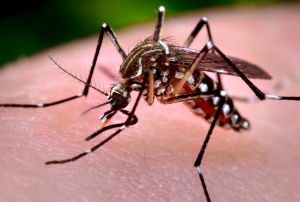Jan 26 2016
The Zika Virus
 The World Health Organization (WHO) and Center for Disease Control (CDC) are warning about yet another virus epidemic, the Zika virus. It may seem like such warnings are overblown, but they do need to be taken seriously.
The World Health Organization (WHO) and Center for Disease Control (CDC) are warning about yet another virus epidemic, the Zika virus. It may seem like such warnings are overblown, but they do need to be taken seriously.
Zika Virus
The Zika virus (Flaviviridae, an arbovirus) is spread through Aedes mosquito bites, the same mosquitoes that also spread Dengue fever. The infections themselves are usually mild, causing fever, rash, joint pain, and conjunctivitis. Many of those infected may even have a subclinical infection, meaning they do not notice any symptoms.
However, the infection can have complications. There is one case report of Guillain-Barre Syndrome (GBS) following a Zika infection. GBS causes inflammation of the lining of nerves resulting primarily in weakness with variable recovery. This does not appear to be a huge risk, but something to monitor.
The bigger concern is about pregnant women being infected. There are numerous reports of poor pregnancy outcomes, mostly microcephaly, in women who have been infected with Zika while pregnant. Microcephaly means small head, and results from poor brain development.
There is currently no treatment for a Zika infection (other than usual supportive care if necessary). There is also no vaccine.
A “Slow Pandemic”
Zika was first identified in Uganda in 1947. It spread throughout Africa, and then spread to Southeast Asia in the late 20th century. Recently it has also spread to South America and Mexico, with Brazil being a particular hot spot.
There are as yet no cases of locally acquired Zika in the US. There have been a few cases of people returning from travel to South America with a Zika infection. It is possible for Zika to become endemic in the US.
The virus can spread wherever there are Aedes mosquitoes, which exist throughout the Americas except for Peru and Canada. Interestingly, these mosquitoes were previously localized to the tropics and subtropics, but have been spread as invasive species by human activity – paving the way for later viral infections.
Zika is in the news now because the pace of spread has dramatically increased. It is no longer a “slow” pandemic, but rather is spreading rapidly.
What to Do?
As there is no treatment or vaccine for Zika, basic precautions are necessary. This mostly involves limiting mosquito populations and avoiding exposure. Mosquitoes breed in standing water, even small puddles or containers with water. Eliminating any standing water is therefore an important measure.
Ponds and lakes can also be sprayed. In the US, the CDC embarked on a campaign to eliminate malaria in the South through control of mosquito populations, and they were successful. So it is possible to reduce mosquito populations to such a degree that infections cannot spread – although malaria is not a virus, which may be more difficult to control.
Meanwhile, those living in areas with the mosquitoes can use repellent, keep their windows closed, use mosquito nets and take other measures to avoid being bitten.
The WHO and CDC are advising pregnant women not to travel to areas where there is currently an outbreak of the Zika virus. They are also suggesting that women who live in an area of an active outbreak might want to delay pregnancy, although they acknowledge this is a very personal decision.
Implications
There are a few lessons to be learned from the recent Zika outbreak. As a skeptical science communicator I find there is a delicate balance between giving people an appropriate warning without causing undue alarm. We are often in the position of pulling back overhyped fears. We also criticize the abuse of the precautionary principle.
The precautionary principle, properly applied, is legitimate, however, and sometimes there is a good reason for concern. Infectious disease is a real problem in our highly populated world with robust world-wide travel. The human population is essentially a breeding ground for bugs.
There have been serious pandemics in the past. Perhaps the most famous was the flu pandemic of 1918, which killed between 20-40 million people (more than World War I).
Also keep in mind that HIV was unknown before the early 1980s. This virus, which also came out of Africa, simmered undetected for many years then exploded, and is now a worldwide medical problem affecting millions. This one virus literally changed the practice of medicine.
We certainly don’t want to have another pandemic like the 1918 flu or another chronic infection like HIV. It is, perhaps, inevitable that we will, however. Bacteria, viruses, and other infectious agents evolve. Change is their major adaptation.
There have also been times when health organizations have issued warnings that then did not turn out to be a big deal, such as the bird flu and the swine flu. Do not let these incidents make you feel that the warnings were overblown. It is the job of the CDC and WHO to anticipate possible epidemics or pandemics and take measures to prevent or minimize them.
If they are functioning optimally there will be a certain number of false positives. False positives are far better than false negatives – missing or underpreparing for an epidemic. We therefore have to tolerate occasional false alarms and not let that make us cynical towards the next warning.
The Zika virus also is a reminder of the importance of world-wide control of infectious disease. We should be concerned about the spread of infections in the third world because it is the ethical and right thing to do. However, it is also important to recognize that we live in a world-wide community. When we allow infections to simmer in distant parts of the world, those infections might eventually work their way around to our part of the world. We are all in this together.






